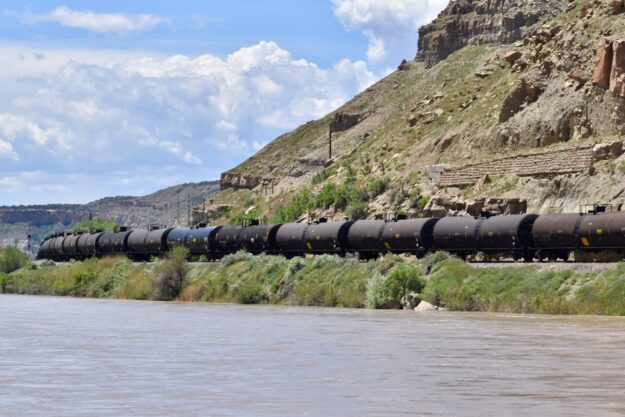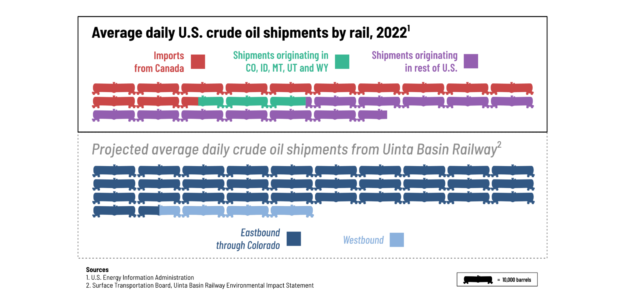Widgetized Section
Go to Admin » Appearance » Widgets » and move Gabfire Widget: Social into that MastheadOverlay zone
Down the Line: A by-the-numbers look at just how much proposed Utah oil trains would impact Colorado railroads

Oil tanker cars on a train using the Union Pacific tracks along the Colorado River near Cameo in western Colorado (Chase Woodruff/Colorado Newsline photo).
This much is clear: The Uinta Basin Railway, an 88-mile railroad extension proposed by a public-private partnership in eastern Utah, would dramatically increase the amount of hazardous materials being shipped through Colorado.
Exactly how dramatic that increase would be, however, is a difficult question to answer.
Virtually all major freight rail routes in Colorado — and every other state west of the Mississippi — are owned and operated by two corporations, Union Pacific and BNSF. Citing competitive and national-security concerns, railroad companies closely guard information about the freight that moves on their rails, especially when it comes to hazardous materials like crude oil.
As a result, solid data about rail traffic levels is hard to come by — even for state and local government entities like the Colorado Department of Transportation and its top safety officials.
“(Railroads) being private companies, and owning all of the rail lines, will always be a challenge for our ability to get data,” said Craig Hurst, manager of CDOT’s Freight Mobility and Safety Branch. “They’ve always been good partners, but there’s a line — like, ‘Okay, this is where private business takes over, and this is where government doesn’t have a say any longer.’”
The multibillion-dollar Uinta Basin Railway project — which would connect Utah’s largest oil field to the national rail network and allow drillers there to ship the basin’s waxy crude oil to out-of-state refineries — has drawn fierce opposition from Colorado communities and elected officials
In a “downline analysis,” federal regulators with the Surface Transportation Board predicted that almost all of the oil-train traffic generated by the new railway would be routed through western and central Colorado on its way to the Gulf Coast.
A compilation of summary data and high-level estimates drawn from a variety of sources — including the railway’s supporters, county-level officials, federal transportation regulators and an energy agency — helps paint a picture of the Uinta Basin Railway’s major implications for rail traffic in Colorado.
Increased oil production
The Seven County Infrastructure Coalition, the group of Utah county governments that has spearheaded the railway’s development, told STB regulators that the project would result in the production of an additional 130,000 to 350,000 barrels of crude oil per day in the Uinta Basin. Regulators used those two figures to analyze both a “low rail traffic scenario” and a “high rail traffic scenario.”
On the high end, this increased production, when added to the Uinta Basin’s current output of around 90,000 barrels per day, would put the region on par with the Denver-Julesburg Basin in Weld County, currently the largest oil field in any Rocky Mountain state.
It would result in as much as 53 million additional tons of greenhouse gas emissions annually — the equivalent of opening more than 14 new coal-fired power plants, and double the projected climate impact of the controversial Willow Project in Alaska.
The high-traffic scenario would amount to roughly 500 tank cars full of crude oil, making up five trains nearly two miles in length, exiting the Uinta Basin every day. After making the first leg of their journey on the new 88-mile Uinta Basin Railway, they would move onto existing Union Pacific tracks near Kyune, Utah.
From there, about 10% of those cars would be shipped west to the Pacific Northwest, the STB’s “downline analysis” estimated. The rest would be bound for Texas, Louisiana and Oklahoma — and all eastbound routes would take the oil trains directly through the Colorado River Valley and the Denver metro area.
Increased rail traffic
In an environmental impact statement finalized in 2021, STB regulators wrote that the 450-mile segment between Kyune and Denver currently has a “low volume of rail traffic relative to the predicted traffic on the proposed rail line.”
While acknowledging that rail traffic can vary considerably from month to month and year to year, the report based its analysis on estimates that the Union Pacific railroad west of Denver sees an average volume of 4.2 trains per day — two of which are short Amtrak passenger trains. Average freight traffic on the corridor amounts to about 114 cars per day, the report said.
With an estimated 450 tank cars passing from Utah into Colorado each day, that means the Uinta Basin Railway’s high-traffic scenario would nearly quintuple the amount of freight traffic on the Western Slope.
Even before the hazardous contents of the oil trains are taken into account, such a large increase in freight traffic would have consequences. Communities fear a rise in collisions with cars and trucks at grade crossings, greater pedestrian safety risks and more wear and tear to infrastructure.
“Whatever risks there may be — and there are always risks — those simply are magnified,” said Matt Scherr, a commissioner in Eagle County, which has sued the STB to overturn the railway’s approval. “When you increase volume, you will increase incidents.”
Increased hazmat volumes
The railway’s backers have downplayed concerns about its impact, noting that plenty of hazardous materials already travel by rail through “downline” communities in Colorado.
“These things and far more are already going through their backyard every day,” Keith Heaton, the SCIC’s executive director, said in an interview.
Railroads are particularly tight-lipped about which specific hazardous materials are transported on their tracks, and when. But summary data shared with county governments gives a broad overview of the total volume of hazmat shipments in a given year.
Andy Martsolf, director of the Emergency Services Division of the Mesa County Sheriff’s Office, told Newsline in an email that a “commodity flow study” showed that 550 million gallons of hazardous materials were shipped by rail within the county in 2021.
“Commodity flow studies are classified as sensitive security information as well as trade secrets by the rail industry,” he wrote, explaining that no further information could be released.
The 550 million gallon figure represents an average of about 50 tank cars passing through Mesa County daily. Even under the low-traffic scenario, the Uinta Basin Railway would nearly quintuple that figure. Under the high-traffic scenario, the railway would lead to a roughly tenfold increase.
Meanwhile, in Denver, where there’s a higher level of current rail traffic on other routes heading north, south and east from the city, the railway would quadruple hazmat shipments, officials there said earlier this year.
Increased oil-by-rail shipments
At a capacity of up to 350,000 barrels per day, and with no prospect of a pipeline coming along to replace it, the Uinta Basin Railway would rank among the largest sustained efforts to ship crude oil by rail ever undertaken in the U.S.
Under the high-traffic scenario, it would singlehandedly more than double the average of around 268,000 barrels per day that were shipped by rail across the entire country last year, data from the U.S. Energy Information Administration shows.
Only a small portion of that total came from a five-state Rocky Mountain region that includes Utah, according to the EIA. Based on the agency’s data, traffic generated by the Uinta Basin Railway could increase crude oil shipments originating in the region by nearly 1,500%.

A limited amount of Utah’s waxy crude oil already travels through Colorado from the Uinta Basin after being hauled by truck to existing rail terminals, according to STB regulators and public statements by Utah oil executives. Other crude oils and petroleum products are also shipped by rail to and from facilities like the Suncor Energy oil refinery near Denver, where a train of mostly empty tank cars derailed last month, and a small Suncor terminal in Grand Junction.
Environmental activists have labeled trains hauling these combustible fossil fuels “bomb trains.” A rise in oil-by-rail shipments in the mid-2010s resulted in a series of fires and explosions across the U.S. and Canada.
In Denver, the burdens of heavy rail traffic have long been borne by predominantly low-income and Latino communities located near the rail yards and industrial spurs on the city’s north side. A report released last year by advocacy group GreenLatinos faulted railroad companies and federal regulators for a lack of transparency about freight trains that can pose disproportionate health and safety risks to those communities.
“We did not find clear explanations for the lack of public access to freight rail information … It remains unclear why freight train data is more protected than that of planes or ships (for which real-time journey information is publicly available by federal law),” the GreenLatinos report said. “Publicly available aggregate information about local rail traffic could assist local governments in setting policies and allocating resources to further prevent injuries and deaths.”
Editor’s note: This story is part of a series that first appeared on Colorado Newsline, which is part of States Newsroom, a network of news bureaus supported by grants and a coalition of donors as a 501c(3) public charity. Colorado Newsline maintains editorial independence. Contact Editor Quentin Young for questions: info@coloradonewsline.com. Follow Colorado Newsline on Facebook and Twitter.
Chase Woodruff
Latest posts by Chase Woodruff (see all)
- Evans, Boebert defend Medicaid cuts as protesters shout them down in Denver - May 30, 2025
- Colorado officials envision Mountain Rail by 2026, Denver to Boulder to Fort Collins by 2029 - May 19, 2025
- Colorado’s Evans votes in favor of bill that will kick at least 7.6 million people off Medicaid coverage - May 15, 2025


